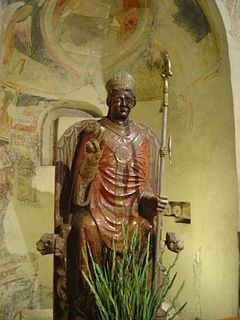Antipope Felix, was a Roman archdeacon in the 4th century who was installed irregularly in 355 as an antipope and reigned until 365 after Emperor Constantius banished the current pope, Liberius. Constantius, following the refusal of the laity to accept Felix, attempted to have them co-rule, but Felix was forced to retire. He was resented in his lifetime but has enjoyed a more popular memory since. Antipope, in the Roman Catholic church, described any figure attempting to oppose the legitimately elected Bishop of Rome, with Felix being among the unsuccessful.
Pope Liberius was the bishop of Rome from 17 May 352 until his death. According to the Catalogus Liberianus, he was consecrated on 22 May as the successor to Pope Julius I. He is not mentioned as a saint in the Roman Martyrology. That makes him the earliest pontiff not to be venerated as a saint in the Roman Rite and one of only two popes to be omitted from Roman Catholic sainthood in the first 500 years of church history.

Germanus of Auxerre ; c. 378 – c. 442–448 AD) was a western Roman clergyman, who was bishop of Auxerre in Late Antique Gaul. He abandoned a career as a high-ranking government official to devote his formidable energy towards the promotion of the church and the protection of his 'flock' in dangerous times: personally confronting, for instance, the barbarian king "Goar". In Britain he is best remembered for his journey to combat Pelagianism in or around 429 AD, and the records of this visit provide valuable information on the state of post-Roman British society. He also played an important part in the establishment and promotion of the Cult of Saint Alban. The saint was said to have revealed the story of his martyrdom to Germanus in a dream or holy vision, and Germanus ordered this to be written down for public display. Germanus is venerated as a saint in both the Roman Catholic and Orthodox churches, which commemorate him on 31 July.

Zeno of Verona was either an early Christian Bishop of Verona or a martyr. He is a saint in the Roman Catholic Church and in the Eastern Orthodox Church.

Apollinaris of Ravenna is a Syrian saint, whom the Roman Martyrology describes as "a bishop who, according to tradition, while spreading among the nations the unsearchable riches of Christ, led his flock as a good shepherd and honoured the Church of Classis near Ravenna by a glorious martyrdom."

Constantius of Perugia is one of the patron saints of Perugia, Italy.

Saint Prosper of Reggio is an Italian saint. Tradition holds that he was a bishop of Reggio Emilia for twenty-two years. Little is known of his life, but documents attest that he was indeed bishop of Reggio Emilia in the fifth century.

Saint Evasius is believed to have been a missionary and bishop of Asti, in north-west Italy. He was forced to flee to the great Padan forest known as the Selva Cornea, where he and numerous followers were beheaded by pagan, or alternatively by Arian, enemies in the area of what is now Casale Monferrato. He is venerated as a saint of the Roman Catholic Church and is the patron of a number of towns in Piedmont and Lombardy. His cult is liveliest at Casale, where his remains are conserved in the cathedral dedicated to him.
Saint Vitalian(us) of Capua was a 7th-century bishop of that city.

Eusebius of Rome, the founder of the church on the Esquiline Hill in Rome that bears his name, is listed in the Roman Martyrology as one of the saints venerated on 14 August.

Saint Chiaffredo is venerated as the patron saint of Saluzzo, Italy. Tradition considers him a member of the Theban Legion, but instead of being martyred with this legion at Agaunum, he escaped to Piedmont and was martyred there.
Simplicius, Constantius and Victorinus are venerated as Christian martyrs of the 2nd century. Simplicius, was, according to tradition, a Christian of the Abruzzi region who was executed along with his two sons, Constantius and Victorian, during the reign of Marcus Aurelius. Their Passio contains all of the tropes of the genre. It is believed that the martyrdoms are genuine but that the three martyrs were not necessarily related to one another, but were executed together at Marsica.

Saint Nonnosus, also Nonosius, was a prior at the San Silvestre monastery on Monte Soratte north of Rome and later a monk at Suppentonia, near Civita Castellana. He was a contemporary of Saint Benedict of Nursia. Alban Butler has written that “so little information has survived about Nonnosus that he is not especially interesting in himself.” His name does not appear in any ancient martyrology.
Saint Magnus of Anagni, also known as Magnus of Trani or Magnus of Fabrateria Vetus, is venerated as the patron saint of Anagni.

Saint Constantius is venerated as a member of the legendary Theban Legion. Similar to the cults of Saint Chiaffredo at Crissolo, Saint Bessus at Val Soana, Saint Tegulus at Ivrea, Saint Magnus at Castelmagno, and Saint Dalmatius at Borgo San Dalmazzo, the cult of Saint Constantius was linked with that of the Theban Legion to lend antiquity to a local saint about whom nothing was really known.

Aquino is a town and comune in the province of Frosinone, in the Lazio region of Italy, 12 kilometres (7 mi) northwest of Cassino.

Saint Titian of Oderzo was a 7th-century bishop of Opitergium (Oderzo), in the Province of Treviso.
Saint Pelinus or Pelinus of Brindisi was a Basilian monk, later bishop of Brindisi in Italy, martyred at Corfinio and made a saint in 668. His feast day is Dec. 5.
Constantius was a Bishop of the Catholic Church who, after many years wandering, became the patron saint of Capri.

Aquino Cathedral is a Roman Catholic cathedral in Aquino, Lazio, Italy. It is dedicated to Saints Constantius of Aquino and Thomas Aquinas.











